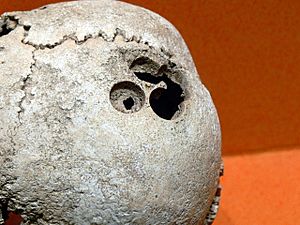Trepanation in Mesoamerica facts for kids
Trephination in Mesoamerica was a practice where ancient people in the Mesoamerican region carefully opened or drilled into the skull of a living person. This happened for a very long time, starting around 1500 BCE (Before Common Era) and continuing until about 1200 CE (Common Era). People used special tools to do this, sometimes by drilling, cutting, or rubbing away the bone. The reasons for trephination could be medical, like to relieve pressure or help with other health problems. It could also be for rituals or experiments. We know about this practice from old human skulls found in burials, pictures in ancient art, and reports from the time when the Spanish arrived.
Contents
What is Trephination?
Trephination is a very old medical procedure that has been done by many different cultures around the world. We have found evidence of it from as far back as the Neolithic period, which was the Stone Age. Even today, some cultures still use similar methods in special situations.
When a person survived this operation, their bone would slowly start to grow back around the edge of the hole. This new bone is thinner than the original bone. Scientists can look at a trephinated skull and see this new bone growth. This helps them figure out if the person lived for some time after the surgery.
In the New World (North and South America), trephination was most common in the Andes mountains, especially among the Inca people. There, it was often done to fix head injuries. It seems like it was a pretty successful medical procedure for them. Some experts believe that more than 70% of patients survived the operation. Recent discoveries even suggest that the survival rates might have been as high as 80% to 90%!
However, in Mesoamerican civilizations, we find much less evidence of trephination. This means it was not as common there, at least based on the number of trephinated skulls found. Still, we have found clear proof that real trephination (done on living people) did happen in Mesoamerica.
Where We Found Evidence
Old Spanish Records
When the Spanish came to the Americas in the 1500s, they wrote down what they saw. People like Bernardino de Sahagún and Bishop Diego de Landa wrote about Mesoamericans using trepanation. They said it was used to help with pain, such as bad headaches. It was also used to relieve pain from another practice: deliberately changing the shape of a person's head for beauty, using boards and other tools.
Central Mexico and Oaxaca Discoveries
One of the first studies of trephinated skulls was done in the late 1800s. It looked at skulls found in the Tarahumara mountains by a Norwegian expert named Carl Sofus Lumholtz. Later, more cases were found in places like Oaxaca and central Mexico. Important sites include Tilantongo and the big Zapotec city of Monte Albán.
Two skulls from the Tlatilco culture, which was around 1400 BCE, also suggest that trephination has a very long history in the region.
In 1999, a study looked at seven trephinated skulls from Monte Albán. These skulls had one or more oval-shaped holes drilled or worn into the top of the head, specifically on the upper Parietal bones. The skulls belonged to both men and women. About half of them showed signs that the bone had healed around the holes. This means those people survived the operation. Most of these skulls also showed signs of earlier head injuries. This suggests that, like in the Andes, the operations were an attempt to fix or relieve problems from these injuries.
It seems that the earliest trephination involved simply rubbing away the bone. Later, people started to combine this with drilling and cutting techniques. Skulls found in Cholula show another type of trephination. Here, a shallow dip was worn into the back of the skull, but it didn't completely go through the bone.
Maya Region and Yucatán Peninsula Discoveries
In the Maya region (southern Mexico, Guatemala, and the Yucatán Peninsula), the skulls found don't show the drilling or cutting methods seen in central Mexico. Instead, the ancient Maya seemed to use a rubbing technique. They would grind away at the back of the skull, making the bone thinner and sometimes even making a hole. This is similar to the examples from Cholula.
Many of the skulls from the Maya region are from the Postclassic period (around 950–1400 CE). Some were found at Palenque in Chiapas, and others came from the Sacred Cenote (a natural sinkhole) at the famous site of Chichen Itza in northern Yucatán.
The Maya people also commonly practiced deliberate head shaping or flattening. This was done from infancy using cradleboards and other tools to press on the growing skull. This created different head shapes, and the style varied depending on the region and time period. Both males and females had their heads shaped, and it wasn't just for rich or important people. It was very common. One study looked at over 1,500 skulls from the Maya region and found that at least 88% showed some kind of intentional head shaping. These practices didn't have any known medical benefits, but they were likely important for Maya culture, beliefs, and identity. Some experts, like Vera Tiesler, believe that trepanation among the Maya also had a special cultural meaning, not just a medical one.


